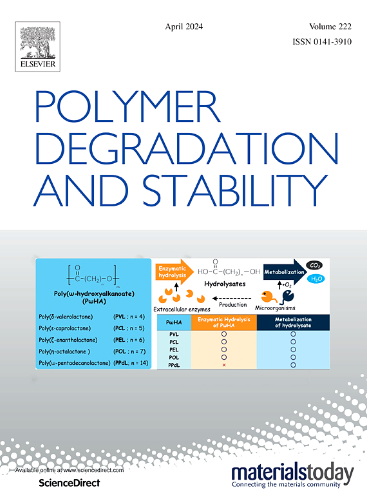环保设计的双层涂层棉织物,具有阻燃和屏蔽电磁干扰双重功能
IF 6.3
2区 化学
Q1 POLYMER SCIENCE
引用次数: 0
摘要
随着5G通信技术的快速发展,开发一种兼具阻燃和电磁屏蔽性能的多功能棉织物,用于尖端电子通信设备是必不可少的。本研究以磷酸、海藻酸钠(SA)和MXene为原料,采用简单的一步法制备了高效阻燃涂料。由于磷酸化海藻酸钠(PSA)催化了棉织物的炭化,而MXene作为物理屏障,在4.7 wt%的超低添加量下,该涂层对棉织物表现出优异的阻燃效果(CT-MP-1的UL-94等级为V-0,极限氧指数(LOI)为24%)。经垂直可燃性测试,CT- mp -3的极限氧指数达到35%,燃烧损伤长度比纯棉(CT)减少了30 cm至11 cm。热重测试证明,CT-MP-3在800℃时炭渣含量达到10.15%。锥形量热仪测试表明,CT- mp -3的总放热量(THR)和峰值放热率(PHRR)分别比CT降低了39.5%和84.6%。此外,在CT-MP-3表面喷涂MXene溶液作为电磁干扰(EMI)屏蔽层,使CT-MP-3-m3达到EMI屏蔽效果(~ 20 dB)。综上所述,本研究为制备具有优异阻燃性能的电磁干扰屏蔽棉织物奠定了基础,为电子通信设备的电磁干扰屏蔽和阻燃提供了一种新的方法。本文章由计算机程序翻译,如有差异,请以英文原文为准。
Eco-friendly design of double-layered coated cotton fabrics for dual-functional flame retardancy and electromagnetic interference shielding
With the rapid development of 5G communication technology, it is essential to develop a multifunctional cotton fabric with both flame retardant and electromagnetic shielding properties for cutting-edge electronic communication equipment. In this study, a high-efficiency flame retardant coating was prepared by a simple one-step method using phosphoric acid, sodium alginate (SA) and MXene as raw materials. Due to the phosphorylated sodium alginate (PSA) catalyzing the charring of cotton fabrics and MXene acting as a physical barrier, the coating exhibited excellent flame retardant efficiency against cotton fabrics at an ultra-low addition of about 4.7 wt% (CT-MP-1 achieved a UL-94 rating of V-0 and a limiting oxygen index (LOI) value of 24 %). After vertical flammability test of CT-MP-3, the limiting oxygen index was reached 35 %, and the length of combustion damage was reduced from 30 cm to 11 cm compared with pure cotton (CT). Thermogravimetric testing proved that CT-MP-3 reaches 10.15 % of char residue at 800°C. Cone calorimeter test showed that the total heat release (THR) and the peak heat release rate (PHRR) of CT-MP-3 decreased by 39.5 % and 84.6 % compared with CT, respectively. In addition, MXene solution is sprayed on the surface of CT-MP-3 as an electromagnetic interference (EMI) shielding layer, so that CT-MP-3-m3 can achieve EMI shielding effect (∼ 20 dB). In conclusion, this study lays a foundation for the preparation of EMI shielding cotton fabrics with excellent flame retardant properties, and provides a new method for EMI shielding and flame retardant of electronic communication equipment.
求助全文
通过发布文献求助,成功后即可免费获取论文全文。
去求助
来源期刊

Polymer Degradation and Stability
化学-高分子科学
CiteScore
10.10
自引率
10.20%
发文量
325
审稿时长
23 days
期刊介绍:
Polymer Degradation and Stability deals with the degradation reactions and their control which are a major preoccupation of practitioners of the many and diverse aspects of modern polymer technology.
Deteriorative reactions occur during processing, when polymers are subjected to heat, oxygen and mechanical stress, and during the useful life of the materials when oxygen and sunlight are the most important degradative agencies. In more specialised applications, degradation may be induced by high energy radiation, ozone, atmospheric pollutants, mechanical stress, biological action, hydrolysis and many other influences. The mechanisms of these reactions and stabilisation processes must be understood if the technology and application of polymers are to continue to advance. The reporting of investigations of this kind is therefore a major function of this journal.
However there are also new developments in polymer technology in which degradation processes find positive applications. For example, photodegradable plastics are now available, the recycling of polymeric products will become increasingly important, degradation and combustion studies are involved in the definition of the fire hazards which are associated with polymeric materials and the microelectronics industry is vitally dependent upon polymer degradation in the manufacture of its circuitry. Polymer properties may also be improved by processes like curing and grafting, the chemistry of which can be closely related to that which causes physical deterioration in other circumstances.
 求助内容:
求助内容: 应助结果提醒方式:
应助结果提醒方式:


